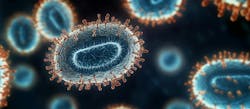Evidence for “substantial” monkeypox transmission before symptoms
A UK study published by The BMJ found evidence for “substantial” monkeypox transmission before symptoms appear or are detected (known as pre-symptomatic transmission).
Transmission was detected up to a maximum of four days before the onset of symptoms, and the researchers estimate that more than half (53%) of transmission occurred in this pre-symptomatic phase, meaning that many infections cannot be prevented by asking individuals to isolate after they notice their symptoms.
Researchers at the UK Health Security Agency set out to analyze the transmission dynamics of the monkeypox outbreak in the UK.
Their findings are based on routine surveillance and contact tracing data for 2,746 individuals who tested positive for monkeypox virus in the UK between 6 May and 1 August 2022. Their average age was 38 years and 95% reported being gay, bisexual, or men who have sex with men.
The two main measures of interest to the researchers were serial interval (time from symptom onset in the primary case patient to symptom onset in the secondary contact) and incubation period (time from exposure to onset of symptoms).
To estimate this, they linked information on exposure and symptom onset dates from these individuals to their contacts through contact tracing case questionnaires, which they then analyzed using two statistical models.
The models were adjusted for several biases common to virus outbreaks, such as changes in infection rates over time, that would otherwise affect the results.
The mean incubation period was estimated to be 7.6 days in one model and 7.8 days in the other model, while the estimated mean serial interval was 8 days in one model and 9.5 days in the other.
For both models, the median serial interval was between 0.3 and 1.7 days shorter than the median incubation period, indicating that considerable transmission is occurring before the appearance or detection of symptoms.
Analysis of individual level patient data, collected from a subset of patients with more detailed information, seemed to confirm this explanation, with 10 out of 13 case-contact patient pairs reporting pre-symptomatic transmission. Four days was the maximum time that transmission was detected before symptoms appeared.
Based on these results, the researchers say an isolation period of 16 to 23 days would be required to detect 95% of people with a potential infection.





